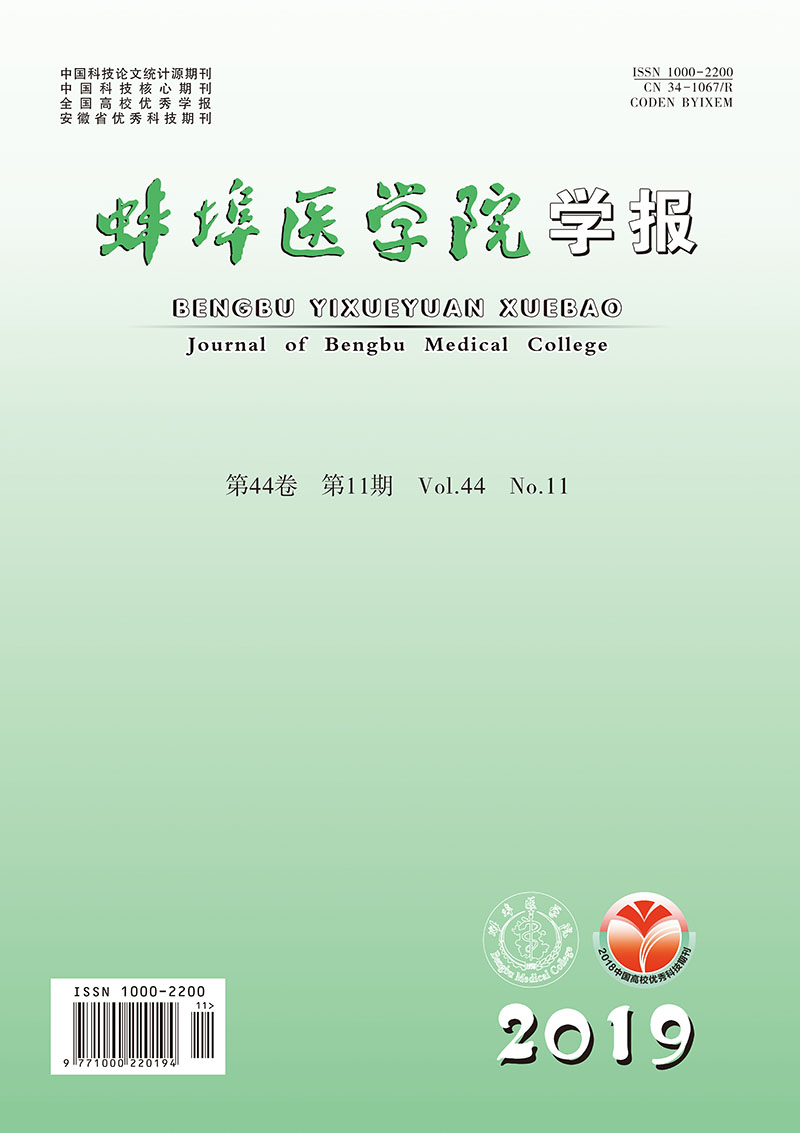-
经前期综合征(premenstrual syndrome, PMS)是指女性在黄体期周期性出现躯体、精神以及行为方面改变的一组症状。PMS周期性反复发作,影响个体的学习和工作效率、社会活动能力及生活质量,甚至发生意外事件[1-4]。其发生可能与经前期激素、神经递质暂时性变化有关,此外还与心理-社会因素等有关,如人格特征、对月经的态度[5]。近年来,个性特征或人格类型对PMS的发生、发展的影响越来越受到关注,国内外研究[6-7]显示女大学生月经前的躯体症状和精神心理症状与个体的个性特点有关,神经质、抑郁质或偏执性倾向强的女性PMS症状更为严重。女大学生处于青春期末期,内分泌系统功能尚不稳定,是PMS易发、高发人群(40%~85%)[8-9]。随着生殖循环发展,PMS对女大学生生理和精神上经常性的潜在累积效应严重影响身心健康,甚至影响对正常生理现象月经的态度。人格具有一定的稳定性,但也具有可变性,大学阶段是学生良好人格不断发展完善、性格重塑的关键期[10]。因此,本文旨在探讨大学生PMS发生现状及其与个性特征、月经态度的关系,为制定科学、有效的防治措施提供参考。现作报道。
HTML
-
2018年10-12月整群抽样选取蚌埠市某高校女大学生作为调查对象,年龄18~23岁。纳入标准:(1)近3个月月经周期规律(25~34 d);(2)知情同意。排除标准:(1)严重的心理疾病者;(2)原发性痛经者;(3)子宫、卵巢有器质性病变者;(4)近3个月有服用避孕药、激素类等药物史者。样本含量大小公式:n=400(1-p)/p,根据文献[8, 11]取p=35%,估算样本量为740。为保证研究结果的可靠性,增加10%样本量,最终选取调查对象820人。
-
该量表调查女性末次月经前14 d至经期出现的12项相关症状,即偏头痛、紧张、嗜睡、失眠、腹胀腹泻、手脚肿胀、坐立不安、注意力不集中、抑郁、焦虑、易激动、神经质等,以出现上述症状中的5项,其中必须具有一项情绪异常症状为诊断标准[12-13]。每项症状4级计分:无症状为0分;症状轻微为1分;症状影响生活、学习和工作,但能忍受为2分;症状严重影响生活、学习和工作,且不能忍受为3分。总分≥6分为PMS,其中6~10分为轻度,11~20分为中度,>20分为重度。该量表Pearson相关系数为0.81,Cronbach′α系数为0.79,有较好的信效度[2, 7]。
-
该量表包括月经属烦恼事件、月经属自然现象、月经为可预测事件、月经影响身心健康的事件、认为月经不影响女性的行为等5个维度,共30个条目,每个条目分为很不同意、不同意、同意、较同意、非常同意,分别计1~5分,总分30~150分。总分≤60分为月经态度积极,61~90分为月经态度中立,>91分为月经态度消极。分数越高,说明在该维度中态度特性越强。该量表Cronbach′s α系数为0.76,能够较为稳定准确地评估女性月经态度。
-
该量表包括外倾性(E量表)、神经质(N量表)、精神质(P量表)、掩饰性(L量表)4个亚量表,共48个题目。所有题目均为是非选择题,“是”=1分,“否”=0分,其中有17个题目为反向计分,即“否”=1分,“是”=0分。根据受测者在各亚量表的总得分(粗分)计算出标准T分,T分=50+10*(X-M)/SD)。T分>61.5~<38.5分为典型;38.5~43.3分或56.7~61.5分之间为倾向型;43.3~56.7分为中间型。其中,L量表(效度量表)是测定受试者的掩饰性程度,≥60分说明问卷无效。该量表E、N和L量表的信度在0.75~0.77,P量表的信度0.58,可以较好测量人格特性[6]。
-
取得辅导员支持,以班级为单位,由经过统一培训的2名研究生进行现场调查。解释调查目的,统一指导语,由调查对象在15 min内独立完成问卷填写。调查者现场收回、检查,补充完善。共发放问卷820份,回收有效问卷803份,有效回收率为97.9%。
-
采用t检验和Spearman相关分析。
1.1. 研究对象
1.2. 调查工具
1.2.1. 经前期综合征量表(premenstrual syndrome scale, PMSS)[12]
1.2.2. 月经态度量表(menstrual attitude questionnaire, MAQ)[14-15]
1.2.3. 艾森克人格问卷简式量表中国版(Eysenck personality questionnaire-revised short scale for Chinese, EPQ-RSC)[1, 6]
1.3. 调查方法
1.4. 统计学方法
-
女大学生PMSS得分0~36分,平均(6.46±5.69)分,其中379人(47.2%)发生PMS,包括轻度209人(55.15%)、中度153人(40.37%)、重度17人(4.48%)。PMS症状主要包括:注意力不集中(62.14%)、易激动(61.15%)、嗜睡(58.78%)及焦虑(55.04%)等;各种症状以轻度为主,症状呈中、重度者包括腹胀腹泻(32.13%)、注意力不集中(28.86%)及嗜睡(27.97%)(见表 1)。
序号 症状 程度 合计 轻度 中、重度 1 易激动 393(80.04) 98(19.96) 491(61.15) 2 抑郁 262(77.51) 76(22.49) 338(42.09) 3 焦虑 344(77.83) 98(22.17) 442(55.04) 4 腹胀、腹泻 283(67.87) 134(32.13) 417(51.98) 5 注意力不集中 355(71.14) 144(28.86) 499(62.14) 6 嗜睡 340(72.03) 132(27.97) 472(58.78) 7 紧张 249(75.45) 81(24.55) 330(41.10) 8 坐立不安 229(74.59) 78(25.41) 307(38.23) 9 偏头痛 150(76.92) 45(23.08) 195(24.29) 10 失眠 162(75.70) 52(24.30) 214(26.65) 11 手脚肿胀 101(78.29) 28(21.71) 129(16.06) 12 神经质 176(79.28) 46(20.72) 222(27.65) -
调查对象MAQ得分30~127分,平均(88.50±10.52)分,其中对月经持积极态度(MAQ≤60分)490人(61.0%)。P量表、E量表、N量表得分分别为36.20~82.13分、22.15~86.66分、33.33~70.01分。PMS组P量表和N量表得分均高于非PMS组(P < 0.01和P < 0.05),E量表得分明显低于非PMS组(P < 0.01),2组MAQ得分差异无统计学意义(P>0.05)(见表 2)。
分组 n EPQ-RSC量表 MAQ P量表 E量表 N量表 非PMS组 424 49.19±9.20 51.20±9.61 46.56±9.07 87.89±10.08 PMS组 379 51.80±10.76 48.65±10.25 53.84±9.59 91.17±10.97 t — 3.7 3.92 2.19 1.87 P — < 0.01 < 0.01 < 0.05 >0.05 -
Spearman相关分析显示,P量表、N量表和MAQ得分均与PMSS得分呈正相关关系(P < 0.01),E量表得分与PMSS得分呈负相关关系(P < 0.01),P量表得分与MAQ得分呈负相关关系(P < 0.01)(见表 3)
项目 1 2 3 4 5 1.P量表 1 2.E量表 -0.176** 1 3.N量表 0.104** -0.235** 1 4.MAQ -0.118** 0.035 0.370** 1 5.PMSS 0.153** -0.117** 0.371** 0.141** 1 **P < 0.01
2.1. 女大学生PMS发生情况
2.2. PMS与非PMS女大学生EPQ-RSC量表和MAQ量表得分比较
2.3. 调查对象个性特征、月经态度与PMS的相关性
-
本研究调查结果显示,女大学生PMS发生率较高,为47.2%(379/803),其中中、重度占44.85%(170/379),明显高于喻琴等[11]调查结果(32.7%、30.17%),与安晓妤等[8]报道相近(49.2%、40.95%)。PMS各症状均以轻度为主,注意力不集中、易激动、嗜睡及焦虑等精神症状为主要表现,与相关研究[11, 17]结果一致。但也有研究[18-19]显示,PMS症状中躯体症状发生率高于情绪症状。PMS发生率及症状的差异性可能与调查方法、样本选择、社会文化等有关。总体而言,女大学生PMS症状中以精神症状多见,而精神症状比躯体症状相对隐蔽、程度各异,而且缺乏足够的客观指标,不易被识别,同时PMS往往被认为是“正常的生理现象”,未引起自身重视,主动寻医行为较少。研究[11]显示,在不同程度PMS中,焦虑、紧张、抑郁等情绪变化的发生率越高,PMS程度越严重,提示学校应重视并加大对PMS知识的宣传教育,制订有针对性的健康指导。
月经态度是个体和社会对于月经的看法和信念,是指个体和社会对月经所持有的固定心理偏向,女性的月经态度既受个体经验的影响,又受社会文化的塑造,可分为积极和消极两个方面[20]。国外研究[21-22]显示,在所有的文化环境中,对月经的态度都是消极的,认为月经是一种负担、一种不必要的烦恼。世界卫生组织的一项调查[9]发现,女性消极的月经态度会加重PMS症状,以易情绪激动、腹痛腹泻、注意力下降等最为常见。本研究结果显示,仅61%的女大学生对月经持较为积极的态度,对月经态度消极或中立态度的为313人(39%),MAQ得分与PMSS得分呈正相关关系,提示对月经态度消极者发生PMS的可能性高。而周期性、反复发生的PMS也会导致个体对月经产生反感、焦虑、害怕心理,导致负性情绪的出现,进一步诱发PMS。因此,学校应重视生殖健康教育,引导学生积极采取正确的经期保健行为,以乐观积极的态度面对月经,以减少或缓解PMS的发生、发展。
个性是一种稳定的心理品质,决定了个体特有的思想和行为。研究[7, 11, 23]发现,女大学生个性特征或人格类型与PMS的发生有一定的关联。本研究结果显示,PMS大学生P量表、N量表得分均高于非PMS大学生,E量表得分低于非PMS大学生。提示PMS个体具有对外界环境适应性差、情绪不稳定、易冲动,对各种刺激反应强烈,易紧张、焦虑、敏感多疑等个性特征,个体性格倾向内化、沉默寡语、不善于交际等。国外研究[23]也证实PMS患病率在外向度较低、神经质较高的学生中较高。Spearman相关分析显示,P量表、N量表得分均与PMSS得分呈正相关关系,E量表得分与PMSS得分呈负相关关系。个性对PMS的影响可能是由于:(1)个性特点与脑活动的固定模式有关,继而影响了下丘脑的活动,使得下丘脑-垂体-卵巢轴(HPO轴)激素分泌紊乱;(2)性格内向、情绪不稳的个体遇到心理应激时,容易产生持久、强烈的情绪反应,进而影响HPO轴的活动与功能;(3)不同的个性特征会影响对月经及PMS各种症状的理解不同。因此,不良的个性特征是PMS的危险因素,而不同个性特点的个体发生PMS的症状的严重程度可能也有所不同。提示高校应重视女大学生良好个性的培养与健全人格的重塑,可以通过多种形式如心理讲座、团体心理辅导与个别咨询等促使学生了解自己的人格特点,积极改变人格中的消极因素;同时,高校应积极对女大学生进行人格及PMS的相关测评,及时采取有效的干预措施和系统管理,着眼于培养良好个性和积极有效的应对方法,从而维护其身心健康。






 DownLoad:
DownLoad: